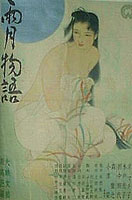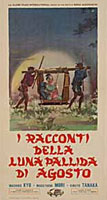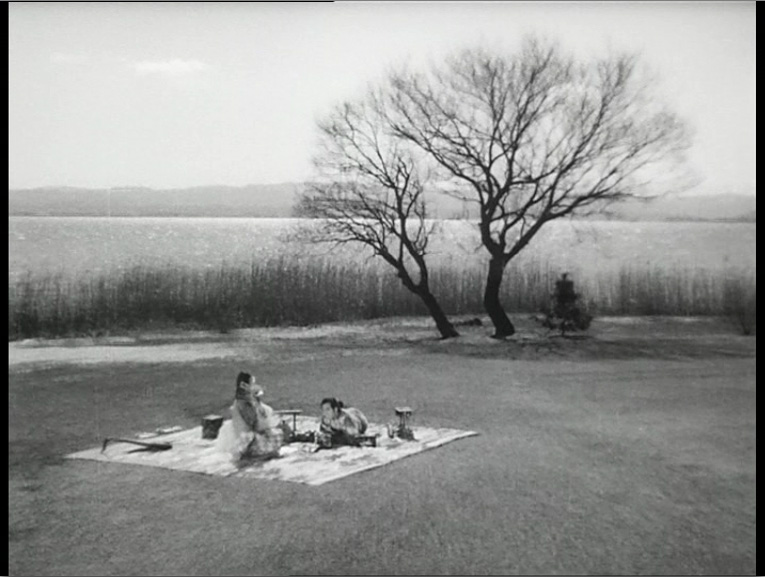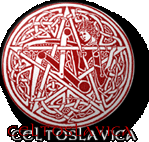
Ugetsu Monogatari
(Ugetsu / Tales of the Pale and Silvery Moon After the Rain
Ugetsu – Erzählungen unter dem Regenmond
Les Contes de la lune vague après la pluie)
by Kenji Mizoguchi

Japan 1953





|
Director:
|
Kenji Mizoguchi | |
|
Producer:
|
Masaichi Nagata | |
|
Production Companies:
|
Daiei Studios | |
|
Screenplay:
|
Matsutarô Kawaguchi, Yoshikata Yoda (based on two stories, Asaji Ga Yado and Jasei No In, from Ugetsu Monogatari by Akinari Ueda) | |
|
Cinematographer:
|
Kazuo Miyagawa (b/w, 1.37:1); | |
|
Editor:
|
Mitsuzô Miyata | |
|
Music Score:
|
Fumio Hayasaka, Tamekichi Mochizuki, Ichirô Saitô | |
|
Art Director:
|
Kisaku Ito | |
|
Costumes:
|
Kusune Kainosho | |
|
Choreographer:
|
Kinshichi Kodera | |
|
Cast:
|
Masayuki Mori (Genjurô, Pottery Maker), Machiko Kyô (Lady Wakasa), Kinuyo Tanaka (Miyagi, Genjuro's Wife), Eitarô Ozawa (Tôbei), Ikio Sawamura (Genichi), Mitsuko Mito (Ohama), Kikue Môri (Ukon) | |
|
Runtime:
|
96 min (2.726 m) | |
|
Premiere:
|
26 March 1953 (Japan)
Production Dates: 26 January - 16 March 1953 |
|
|
Awards:
|
Venice Film Festival 1953: Silver Lion |

|
"Known to American audiences simply as Ugetsu, this was the film which introduced Mizoguchi to the West. During the civil wars of the 16th century, a potter desperately trying to continue his craft in a war-torn village meets a phantom princess and is lured away to a land of sensual delights. Meanwhile his neighbor, dreaming of military glory, achieves a general's rank for his fraudulent exploits. Eventually, both men are brought down to earth, and they return home to spend the rest of their lives in the fields. But for the women of the tale the lesson has been even more bitter: the potter's wife is murdered by bandits, the samurai's is reduced to prostitution; even the ghost princess, Lady Wakasa, is destroyed by male betrayal. Phantoms and ghosts are evoked in imagic scenes, and fantasy and reality are inseparable, making Mizoguchi's stylistically superb film a powerful study in psychology and an intense tragedy. Ugetsu is evocative of the Buddhist universe of Noh drama, where time is a movement of consciousness, memory is as tangible as the present, and the dead return to voice their grief or longing. Blending a tale of karmic law, a ghost story, and a love story, Mizoguchi also refers to other Japanese art forms such as narrative picture scrolls in his use of perspective and his signature long takes that move us seamlessly from one scene to the next. For, just as his images overflow with life-characters forever running off toward more life outside the frame—so this reality flows into the phantom universe as well. He builds the otherworld entirely out of what he is given in this one: shadows and lighting, decor and texture, and the graceful chicanery of desire."
— Pacific Film Archive "Ugetsu Monogatari is an exquisitely realized, serenely composed allegorical film on love, greed, and betrayal. Kenji Mizoguchi's seamless fusion of poetic realism and surreal mysticism creates a rarefied atmosphere that is paradoxically beautiful and austere, redemptive and tragic, symbolizing Genjuro's coexistence between the physical and supernatural realm — a reflection of the duality of the human soul." "Mizoguchi's unique establishment of atmosphere by means of long shot, long takes, sublimely graceful and unobtrusive camara movement, is everywhere evident ... A ravishingly composed, evocatively beautiful film." "L'élégance d'écriture de ce film, le raffinement de tous ses détails sont pour nous riches d'enseignements infinis. Mais, rassurez-vous, je ne prétends pas vous y envoyer comme à l'école. Les Contes de la lune vague possèdent, par-dessus le marché, une qualité dont vous auriez pu douter en lisant mon dithyrambe. C'est un film vif, prenant, enjoué, facile, tour à tour émouvant et plein d'humour. Il n'a point ce caractère solennel, abstrus, des chefs-d'œuvre. Nul hiératisme même, nulle lenteur extrême-orientale,. Vous serez au contraire tout surpris, presque déçus de voir apparaître si vite sur l'écran le mot « fin »." "La subtilité, la richesse sont ici les fruits si difficiles à atteindre de la sobriété classique. Les mots sont quotidiens, l'art est dans leur assemblage. Les plans sont constamment moyens ou généraux, les contre-champs rares et les mouvements d'appareil, courts et précis, dessinent des lignes nettes et efficaces comme celles des estampes. La violence, la faim, la mort sont exprimées avec pudeur, sans images-choc. Dans cette épure, en de tels moments, les visages nous sont épargnés : tout est dit par les lignes mouvantes que tracent des formes humaines gémissantes. ... Ce conte est un poème de sagesse dont le chant est mesuré, plein ; il est la paix même, il est parfois la joie profonde au cœur de la tragédie ; il a le ton, l'orient, la sérénité et la morale, qui sont universels, d'un autre poète de la sagesse, celui du Livre XII des Fables. Cinéma-Audiovisuel – Les contes de la lune vague |
|
|
||
|
Distribution:
|
Fravidis / Opening / Collection Les Films de ma Vie Region 2 (France) |
|
|
Runtime:
|
92:18 min (+ 4% PAL Speedup = 96 min) |
|
|
Video:
|
1.30:1/4:3 FullScreen Average Bitrate: 5.51 mb/s PAL 720x576 25.00 f/s |
|
|
Audio:
|
Japanese Dolby Digital 5.1 Arkamys Mono | |
|
Subtitles:
|
Français (optional) | |
|
Features:
|
• Documentary L'art de Kenji Mizoguchi dans Ugetsu Monogatari, France 1999, by Jean Douchet (Cahiers du Cinéma) (1.33:1, 37:38 min) • Theatrical Trailer (1.33:1, 03:25 min) • Filmography Kenji Mizoguchi |
|
|
|
DVD Release Date: 10 July 2001 Keep Case Chapters: 10 DVD Encoding: PAL Region 2 SS-DL/DVD-9 (3.73 GB/film, 6.02 GB/total) |
|
|
Comment:
|
The print used for this transfer is worn and displays numerous scratches, film splices, blots and tears. Because a print for theatrical release was used, the contrast levels are too high on video. The transfer itself is ok, but is not free from artifacts. The remixed Arkamys 5.1 Mono soundtrack uses the rear speakers for improved "mono surround" sound space (called "ambiophonie"), but the effect is debatable. French subtitles are optional. The extras include a 40-min documentary produced for French TV on the esthetic and artistic techniques and means of Mizoguchi, analyzed through sequences of the film.
Film: ***** out of ***** |
Menu
 |
 |
Frame 2
 |
Frame 3
 |
Frame 4
 |
Frame 5
 |
Frame 6
 |
Frame 7
 |
Average Bitrate :
5.51 mb/s

The Vertical axis represents the bits transferred per second. The Horizontal is the time in minutes
|
This is a strictly non-professional and non-commercial DVD review. Don't expect industry reference work! All ChiaroScuro captures are taken under MacOS X.2 using VideoLAN and Snapz ProX. For further methodological remarks see DVDBeaver (click on "Methodology"): "We are not a lab and are doing a good a job as our time and energy permits. Thank you for understanding." |



